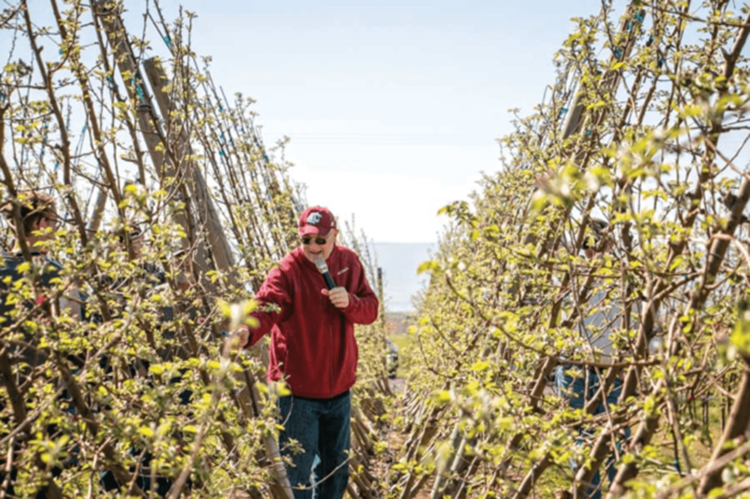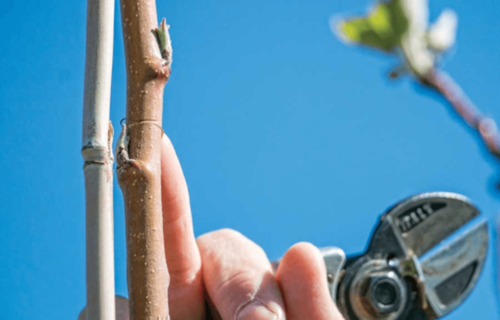Researchers Offer More Tips For Growing WA 38, Including Girdling.

PHOTOS BY ROSS COURTNEY FROM GOOD FRUIT GROWER
Stefano Musacchi, research horticulturalist for the Washington State University Tree Fruit Research and Extension Center, discusses the “click” technique of management on Cosmic Crisp plantings during a field day at WSU test plots. The effects of the click system were less evident in a V-trellis, shown above, because trees are planted closer together.
Researchers are already finding Washington State University’s latest apple variety, WA 38, to be grower friendly, but they’re learning more about it each season as commercial production grows closer.
That includes how to horticulturally manage this highly vigorous, tip-bearing variety, whose apical dominance can result in large caliper branches that present significant blind wood.
“When we get these highly vigorous situations, renewal pruning is going to be a critical component of the horticultural program,” said Tom Auvil, research horticulturist with the Washington Tree Fruit Research Commission. “We have to be very careful about how we prune and thin a vigorous orchard.”
Stefano Musacchi, Washington State University horticulturist and endowed chair in tree fruit physiology and management, notes that this cultivar can produce a high number of secondary clusters, or lateral clusters, on one-year wood, which in some cases can range from 20 to 40 percent of the total flower count on a WA 38 tree.
That’s according to data from WSU’s Sunrise research orchard near Quincy, Washington.
And unlike most other varieties, WA 38, known under the brand name Cosmic Crisp, produces high-quality fruit on spurs and one-year wood.
Managing the blind wood also offers other benefits: It reduces the amount of bloom that could be struck by fire blight, minimizes transplant issues and keeps the fruit all in one place, next to the tree, which will be ideal for mechanical harvest, Auvil said.
“And technically, I think it will improve yields, because the more sites where fruit can grow, the less blind wood, the more fruit we’ll harvest,” he said.
Researchers presented their latest findings on WA 38 horticultural practices in April during tours of two plantings at WSU’s research orchards in Quincy and Prosser, Washington.
Reducing The Blind Wood
Musacchi recommends notching and girdling just as deep as the bark and phloem to reduce blind wood. He says bending tends to result in two to three more nodes of blind wood than clicking-type pruning methods.
Researchers have examined a number of ways to minimize the other effects of apical dominance in WA 38, including girdling and notching the central leader and different pruning techniques — a “click” system vs. bending limbs and fastening to the trellis wire.
Musacchi is adopting a click pruning technique. This method involves tipping the end of the branches on one-year wood to minimize the blind wood.
Tipping once at 1 year old, then returning the following year to tip again, leaving two to three vegetative buds, will help to increase bud swelling at the base of the branch and reduce the blind wood.
Bending tends to result in two to three more nodes of blind wood than clicking-type pruning methods, Musacchi said.
Girdling is ideal for WA 38 trees on a bi-axis training system, because growers don’t want to lose 2 feet of crop to blind wood, especially in a fruiting wall, Musacchi said.
He recommends a very light girdle around just the bark and the phloem, “every foot, sometimes even more often — every 5 to 6 inches — if necessary.”
“Honestly, the girdling did extremely, extremely well,” he said. “There is no blind wood through all the length of the fruiting wall.”
Musacchi did not girdle a spindle block planted as finished trees, which had significant feathers — 20 to 30 feathers per tree for trees on Geneva 41 rootstocks, and 10 to 15 feathers per tree for those on Malling 9 Nic 29 rootstocks. This means that girdling can be adopted only if necessary.
Generally, the click system is resulting in better bud breaks the following year, but it’s more effective in vigorous conditions, Musacchi said.
However, in a V system, because the trees are planted closer together and are less vigorous, the effects were not as evident, because the length of the branches is shorter.
In addition, a mechanical pruning trial at the Prosser, Washington, site is showing promise. Mechanical pruning cuts off the tips of branches, thus removing their inherent apical dominance, and helps to stimulate bud break closer to the trunk, or axe, of the tree and minimize blind wood, Musacchi said.
Researchers mechanically pruned for the first time last year, then did so again in February.
The result: Every cut is resulting in one, two or three buds close to the axe, minimizing the blind wood and ensuring short limbs that improve fruits’ exposure to sunlight.
Mechanically pruning also prepares a fruiting wall for mechanical harvest in a couple of different ways, Auvil said.
Eliminating longer fruiting limbs from rows reduces the potential for damage by limbs that could be sucked into a vacuum harvester, damaging fruit that enter the machine when a limb is in the wrong place.
“The other really, really big advantage for the robotics format, particularly for the bi-ax system, in looking at mechanical pruning, is the uniformity of color and maturity,” he said.
Pollinizer Reminder
Researchers are also reminding growers who intend to plant WA 38 to remember to order their pollinizers.
Growers should strive to get two different pollen sources distributed in each block — every 30 feet for every row — such as a Mount Everest and a Snowdrift, or midseason commercial apple varieties, such as Red Delicious, Golden Delicious, Granny Smith or Cameo, Auvil said.
Article by Shannon Dininny, Good Fruit Grower






